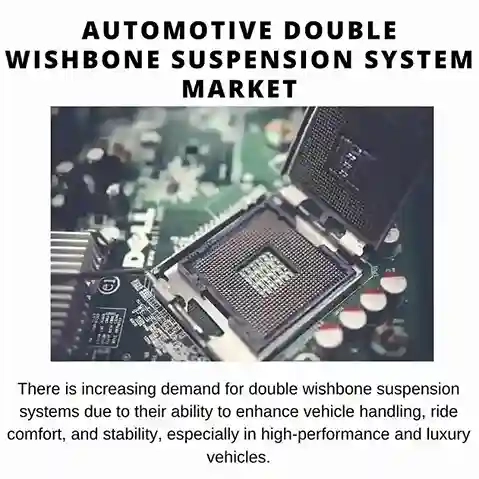
- Get in Touch with Us

Last Updated: Apr 25, 2025 | Study Period: 2024-2030
The automotive double wishbone suspension system market is a sophisticated arrangement used in the suspension systems of vehicles, designed primarily to enhance handling, ride comfort, and performance. The double wishbone suspension consists of two wishbone-shaped arms (also known as A-arms) that are positioned parallel to each other. These arms are typically connected to the chassis at one end and to the wheel hub at the other end.The upper and lower control arms form the main components of the wishbone suspension. They are connected to the steering knuckle or upright, allowing the wheels to move vertically while minimizing changes in camber angle during suspension travel.

Double wishbone suspensions commonly use coil springs and shock absorbers (dampers) to manage vertical movement and damp oscillations. These components play a crucial role in providing ride comfort by absorbing road shocks and vibrations. Double wishbone suspensions offer superior handling characteristics compared to other suspension types. They provide better control over camber angle changes during cornering, resulting in improved stability and reduced body roll.By isolating the cabin from road imperfections, double wishbone suspensions contribute to a smoother and more comfortable ride experience. They effectively absorb shocks and reduce noise, vibration, and harshness (NVH) levels inside the vehicle.
The market for automotive double wishbone suspension systems is characterized by its critical role in enhancing vehicle handling, ride comfort, and performance across various segments. Double wishbone suspensions are widely favored in luxury vehicles, sports cars, and off-road applications where precise control over wheel movement and superior handling dynamics are paramount. These systems offer advantages such as reduced body roll during cornering, improved stability under braking and acceleration, and enhanced overall driving experience due to their ability to maintain optimal wheel alignment and geometry.
The demand for double wishbone suspensions is driven by increasing consumer preferences for vehicles that offer both comfort and performance, especially in premium and high-performance vehicle segments. Automakers are continually integrating advanced technologies such as adaptive damping systems and lightweight materials to improve the efficiency and functionality of double wishbone suspensions. Furthermore, as electric and autonomous vehicles gain traction, the adaptation of double wishbone suspensions to accommodate new drivetrain configurations and autonomous driving technologies presents new opportunities for growth in the market. Overall, the market for automotive double wishbone suspension systems is poised for steady expansion driven by technological advancements and evolving consumer expectations for vehicle performance and comfort.
The market for automotive double wishbone suspension systems is witnessing robust regional growth, led by strong adoption in Asia-Pacific fueled by rapid industrialization and infrastructure development initiatives. North America and Europe also contribute significantly to market demand, driven by advancements in automotive technology and manufacturing processes.

Over the next five years, the market is expected to expand steadily, supported by both OEMs and aftermarket segments. However, potential challenges include regulatory uncertainties, economic fluctuations, and shifts in market dynamics. Despite these factors, the industry's adaptability to regulatory changes and continuous innovation are key strengths that bolster its resilience in meeting evolving market demands.
| Sl No | Company | Product Description | Analyst View |
| 1. | ThyssenKrupp Automotive Systems | ThyssenKrupp Automotive Systems launches a groundbreaking double wishbone suspension system for heavy-duty trucks. This innovation enhances ride comfort, safety, and compactness while overcoming challenges like high axle loads and limited space. It integrates advanced suspension technology and materials expertise, setting new standards in commercial vehicle performance and design. | This pioneering solution revolutionizes ride comfort, safety standards, and space efficiency, addressing significant challenges such as managing high axle loads and constrained installation space. By integrating cutting-edge suspension technology and leveraging extensive materials expertise, ThyssenKrupp sets a new benchmark in commercial vehicle performance and design excellence. |
| 2. | Doftek | Doftek launched an innovative adjustable active suspension system for the automotive double wishbone market, developed with Bosch support. This system dynamically adjusted wheel alignment (AWA), enhancing handling, fuel efficiency, and reducing emissions. Initially for luxury and performance vehicles, it offered modes for different driving conditions and achieved significant gains such as 15% better handling, 10% lower rolling resistance, and reduced peak tyre temperatures. | This innovative technology enabled real-time wheel alignment adjustments (AWA), enhancing vehicle handling, fuel efficiency, and environmental sustainability. Initially targeted at luxury and performance vehicles, it featured selectable modes for varying driving conditions, delivering substantial benefits: a 15% boost in handling performance, 10% reduction in rolling resistance, and decreased peak tyre temperatures. |
| 3. | AxleTech International | AxleTech International launched its innovative independent front suspension system tailored for heavy-duty trucks and military vehicles. Featuring a robust double wishbone design with portal ends for enhanced ground clearance, their 3000 series boasted axle capacities exceeding 14,000 lbs and offered gear ratio options from 5.60 to 17.80. With a century-long legacy as the former off-highway division of Rockwell International, AxleTech International demonstrated its expertise in designing and manufacturing components for demanding applications, solidifying its reputation for innovation and capability in the automotive and defense sectors. | Featuring a robust double wishbone design complemented by portal ends for superior ground clearance, their 3000 series boasted axle capacities exceeding 14,000 lbs and offered gear ratio options ranging from 5.60 to 17.80. With a storied history dating back a century as the former off-highway division of Rockwell International, AxleTech International showcased its deep expertise in crafting components for rigorous applications, reinforcing its reputation for innovation and capability in the automotive and defense sectors. |
In the automotive double wishbone suspension system market, leading players are deploying strategic measures like product innovation, partnerships, and mergers and acquisitions to strengthen their market positions. Significant investments in research and development are being made to develop advanced, efficient, and user-friendly suspension systems tailored for diverse automotive applications. Intense price competition underscores the need for manufacturers to maintain a balance between product quality and cost efficiency. Differentiation in this competitive environment is driven by technological advancements and the integration of value-added features. Strategic alliances and acquisitions are also employed to expand market reach and enhance product portfolios.
| Sr.No | Topic |
| 1 | Market Segmentation |
| 2 | Scope of the report |
| 3 | Research Methodology |
| 4 | Executive Summary |
| 5 | Average B2B by price |
| 6 | Growth Drivers for automotive double wishbone suspension system market |
| 7 | Key Constraints For growth of automotive double wishbone suspension system market |
| 8 | Market Size, Dynamics, and Forecast by Geography, 2024-2030 |
| 9 | Market Size, Dynamics, and Forecast by Component type, 2024-2030 |
| 10 | Market Size, Dynamics, and Forecast by Material type, 2024-2030 |
| 11 | Market Size, Dynamics, and Forecast by Vehicle type, 2024-2030 |
| 12 | Competitive landscape |
| 13 | Market share of vendors, 2023 |
| 14 | Company Profiles |
| 15 | Key Innovations and New Product Launches |
| 16 | Strategic Partnerships and Collaborations |
| 17 | Investment Opportunities and Market Entry Strategies |
| 18 | Analysis of Regulatory Impact on the Market |
| 19 | Impact of Technological Advancements |
| 20 | Market Trends and Future Outlook |
| 21 | Analysis of Customer Demand and Preferences |
| 22 | SWOT Analysis of Key Players |
| 23 | Case Studies of Key Players |
| 24 | Recommendations for Stakeholders |
| 25 | Distribution Channels and Sales Analysis |
| 26 | Conclusion |